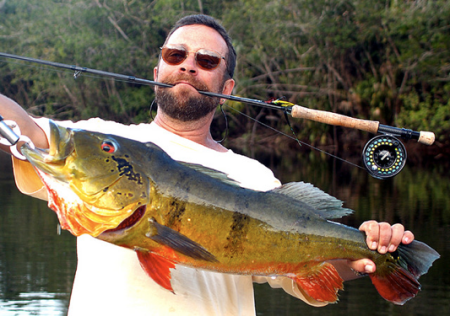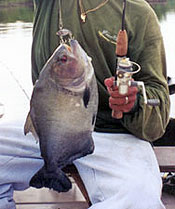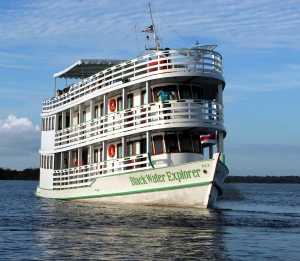Part 2 – Tackle guidelines
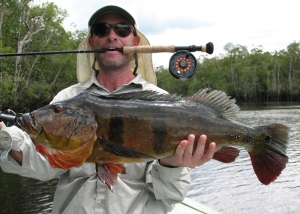
This is what your fly rod was invented for.
Since peacocks can be sight fished or blind cast to structure and since this is a hand-to-hand fight (peacocks can literally snap a fly line like sewing thread – not the leader – the line!!), I’ll recommend some specific equipment that can serve to fit a wide range of peacock bass fly fishing needs and hold up to the challenge. I’m not trying to promote any brand over another here. Feel free to substitute your personally preferred model that suits the purpose. Please note that these recommendations are geared toward fishing for giant Amazon peacock bass (Cichla temensis) and not necessarily the behaviorally different and smaller-sized species that are found outside of the Amazon. All of this gear can be purchased at www.tackle-box.net
Flies
Subsurface Fly Patterns — Large streamers fished on a sinking line are generally the most productive option for fly fishermen (not only in terms of overall numbers of peacocks, but for larger-sized fish as well). We highly recommend Sidewinder’s Peacock Rattle Fly. This fly is designed specifically for peacock bass and incorporates a variety of peacock-specific features.
1. Extra Wide-Gap Hook – Big peacocks have a heavy, thick jawbone. The wide 5/0 gap in the Peacock Rattle Fly’s hook allows it to pass around the jawbone so that it encounters softer tissue, not impenetrable hard bone. With the hook wrapped around its jawbone, the fish’s fighting force is applied at the stress resistant curve of the hook, so that your adversary is unable to apply pressure to the less resistant straight shank
2. Extra Strong Gamakatsu Hook – Peacocks are brutal fighters. Their extraordinary power crushes and straightens lesser hooks like so much tinsel. The Peacock Rattle Fly is built around a high-quality, super-strong 4X hook, to ensure that your trophy doesn’t escape by turning your bait into a pretzel
3. Extra-long Bucktail Material – Bucktail is unique among tying materials in its ability to provide life-like motion. Its hollow hairs naturally float and lend a pulsing motion to a properly fished Peacock Rattle Jig. Its natural flex and springiness can’t be duplicated by most synthetics.
4. Flexible Pulsing tail – Mounted with springy monofilament, the peacock rattle jig’s extended tail flexes and moves naturally. Its bucktail fibers allow it to pulse with the angler’s stripping motion, adding even more enticing, appetizing action.
5. Extended profile – Even the largest deer tails have a limit to the length of their hairs. A simple garden-variety fly is typically limited to about a three inch profile. By adding the Peacock Rattle Jig’s unique tail, the lure’s profile is extended to over 6 inches, providing a more visible, more appetizing stimulus to large peacock bass. The old adage that big baits catch big fish works very well with trophy peacocks.
6. Contrasting Color Pattern – The Peacock Rattle Jig swims with the hook pointing upward when ripped quickly through the water. Just like a natural baitfish, its contrasting colors are arrayed with the darker shade above and the lighter shade below.
7. Flashing sides – Baitfish live and die by the effectiveness of their camouflage. To take best advantage of the natural physics of light in water, they are shiny only on their sides and not on the top or bottom of their bodies. The Peacock Rattle Jig has brilliant flash on its sides, arrayed just like a natural bait, yet highly visible when in motion.
8. Hidden rattle – Tied directly to the shank of the extra-strong hook, the Peacock Rattle fly is armed with a noisy, clacking rattle. Virtually indestructible (plastic – not glass), the rattle provides extra dimensions of sensory output to attract hungry peacocks and makes the fly more effective in murky water than almost any other subsurface lure.
9. Durability – Peacocks strike hard, so these flies are made to last. All components are mechanically anchored and copious amounts of permanent glue are used at every step of the tying process. Although nothing will make it piranha proof, this jig will hold up to the worst a peacock can dish out.
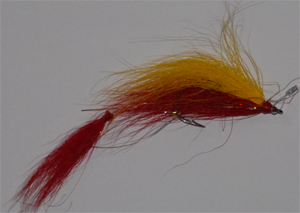
The peacock bass rattle fly
If you wish to tie your own, instructions for tying the similar peacock “Bass Rattle Jig” are available on our website (just substitute the appropriate 5/0 extra -strong hook for the jighead).
Other popular streamers such as big Deceivers, Bunnies, Saltwater Zonkers, Clousser Minnows and flashy baitfish imitations will all take fish. The most effective patterns have contrasting colors and generous amounts of flash.
To most effectively strip these big streamers once you’ve made your cast, hold your rod at arm’s length and point the rod tip at the water. Grasp the line at the rod with your free hand and strip it quickly and sharply to your hip, giving the fly a quickly accelerating 2 to 3 foot motion. Restrain the running line with your rod hand, bring your free hand back to the rod and repeat. The rapidly accumulating stripped line should be managed either at your feet if you’re on a casting platform or into the (carefully prepared to be snag-free) bottom of the boat. Wear a stripping glove on your rod hand or you’ll quickly raise blisters.
A strike will not be subtle. You’ll know it immediately. To set the hook, don’t raise the rod tip, this isn’t a trout. You’ll need a firm strip-set to penetrate the peacock’s tough mouth. Once he’s hooked, raise the rod and see what happens next. Peacocks don’t always panic and run when first hooked with a fly; sometimes they don’t realize they have a problem. If they don’t run right away, take advantage of the moment and try to recover as much line as you can get onto the spool – but get ready for the run, it’s coming. If they do run immediately, here’s where your loose line management technique will either pay off or break your heart. The slightest hitch or hang up will break you off even more quickly than you can think of the appropriate curses bemoaning your bad luck.
The beast will head for the nearest structure. Don’t panic, don’t try to stop him and don’t try to horse him – things will break. Use your head and the extra length and power of your fly rod to lead the fish by sweeping your rod low in the direction you want him to go. Give him an option that’s easier than trying to reach the structure and he’ll likely take it. Once you’ve weathered that first blast, take your time and patiently work him back in. He’ll run many times, each one getting shorter. When you can lift his head out of the water, he’ll stop fighting. Now use your Bogagrip to secure your trophy. Congratulations! You’ve just experienced the ultimate fly rod high.
Surface Flies – In spite of the peacock’s great reputation for surface action (on conventional tackle), surface flies tend to be significantly less productive than subsurface streamers. Fish over 10-pounds are just difficult to coax to the surface with fly rod poppers. Additionally, although big saltwater poppers may be exciting to fish, they can be extremely exhausting to cast and retrieve for a prolonged period. In spite of these negatives and the hard work, extremely large (6-inches or larger) sliders and poppers will sometimes bring up trophy fish …. and a trophy peacock bass crushing a fly on the surface might just be worth the effort. Gaines saltwater poppers in red/yellow and pearl/olive hold up well and are hard to beat in terms of their ‘action’ in the water. ‘Sliders’ are productive in clear water situations. Popovic’s ‘Siliclone Mullet’ in olive and white is effective. Fly shade (depending upon light conditions) can be as important as contrasting color. For this reason have an adequate selection of light and dark patterns.
For a week long peacock bass adventure, we recommend that you bring at least two dozen streamers and several poppers. Hooks must be extra strong, with a wide-gap and razor sharp — dull hooks significantly reduce hookup rate. All of these flies can be obtained from www.tackle-box.net
Fly rods – Rods should be fast action models, since they load sinking lines more efficiently and generally have more ‘backbone’ than softer models. Bring at least two fly rods, because rods can break under the ‘jungle stress.’ Reels don’t need to hold a lot of backing because peacocks don’t make long runs, but a smooth, strong drag is essential. Consider a wide arbor reel with an anti-reverse mechanism. Peacock’s initial runs can be so sudden and so powerful that the spinning reel handle can badly injure a loitering finger. A wide arbor configuration can more easily handle line when getting the fish on the reel and help prevent unexpected line jams.
Recommended ‘heavy’ fly rod & reel combinations: A stiff/fast action, 9-foot, nine or ten – weight rod (G. Loomis GLX, Native Run or Sage 990-3RPLX) with G. Loomis “Current 7 – 8 or Scientific Anglers ‘System 2 -89’ or reel.
Recommended ‘medium’ fly rod & reel combination (for floating lines): A stiff/fast action, 9-foot, seven or eight-weight rod (G. Loomis GL3 or GLX) + matched reel.
Some fisheries have access to smaller waters that hold “cara” (smaller cichlids) and pacu, both great fun on a 4 or 5 weight rod with floating or intermediate lines. But, find out if your destination has this feature before dragging along the extra weight.
Lines – Sinking lines are most effective for streamers. But don’t bring just any old sink-tip and hang it from your line. We recommend a Rio 300-grain Density Compensated line. This line is designed to not get sticky in the tropical heat and more importantly, its weight is distributed along its profile, rather than hanging off the end of your line like a floppy sinker. This allows you to cast most effectively and to take advantage of the line’s design, rather than defeating any line’s natural configuration by unbalancing its end. These lines can be fished effectively on a 9 weight rod. A spooled-up 200 or 150 grain line may be a good extra to carry in the event of unusually shallow conditions.
If you bring a floating line, a model with a drastic weight-forward taper (like Rio LongCast or Scientific Anglers’ ‘Mastery Saltwater Tarpon’) matched to your rod weight will help handle wind-resistant poppers.
Leaders – Peacocks are not the least bit leader shy. If you are not pursuing line class records, most peacock fly anglers use a straight shot (approximately eight feet) of 35-45 pound monofilament leader material. Light leaders can be snapped off like sewing thread if that ten or fifteen ‘pounder’ runs you into a tree or rock pile. You will go through a lot of leader material, because of the peacock’s extremely abrasive teeth. We recommend buying a spool of soft monofilament leader material (Jinkai makes a soft flexible line that behaves like it’s a much lighter weight). If you’re trying for an IGFA record, you’ll have to follow IGFA’s leader specifications, of course.
An Additional Suggestion – Fly fishing for peacocks is extremely productive, but can be tiring if you’re not used to blind casting (and then rapidly stripping) a heavy-weight fly rod all day long. If you don’t think you have this type of endurance, we strongly recommend that you also bring along casting or spinning tackle to give yourself a break. (Many operations, like ours, have conventional tackle on site and available for clients’ use.)
Peacock bass on the fly – they’re not trout and they’re not bass, but with the right equipment and the right techniques they’re more fun than you would have believed possible. This is what the fly rod was invented for. Join us on the trip of a lifetime.
Based on what we’ve covered today in Part 2, we’ll focus in on the fly fishing techniques that are best suited for peacock bass in Part 3 – Fly Fishing Techniques for Peacock Bass. I hope to have it posted here in a week or so. In the meantime, you can see more fly fishing information on our website.
Visit us at; www.acuteangling.com
Follow us on Twitter at; http://twitter.com/PeacockBass
Check out our photos at;
http://www.flickr.com/photos/peacockbass/
Watch our videos at;
http://www.youtube.com/watch?v=wnzi3Skwi9M






